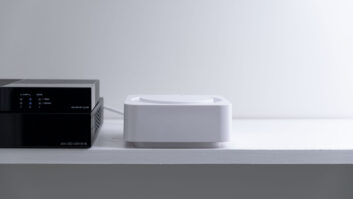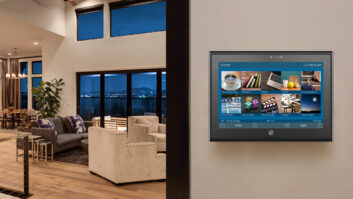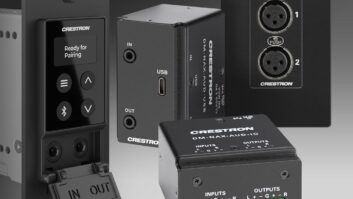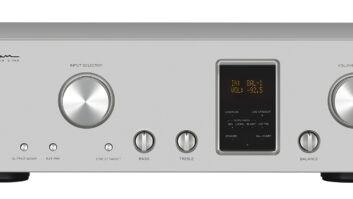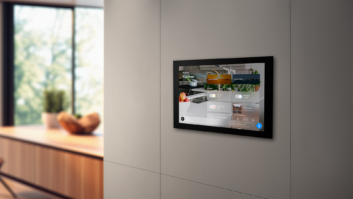This Integration Guide to Touchpanels was sponsored by AMX, Leviton, RTI, and URC as a supplement to Residential Systems, July 2013.

The Crestron TSW touchpanel features a clean, contemporary appearance with edge-to-edge glass and advanced high-definition smart graphics. The impact of mobile devices on the dedicated touchpanel and remote control market cannot be over stated. Swooping in with simple gestures that have become an instinctive second language for consumers, and buttonless and responsive interfaces that have revolutionized how more complex control devices are now conceived, mobile devices and the apps that have driven their market dominance have changed not only how consumers perceive control devices (as more accessible), but also how manufacturers are thinking about designing these devices to capture a less niche end user.
In the residential integration channel, touchpanel and remote manufacturers have thoroughly embraced the wider market trends, delivering spectacular mobile apps to complement their dedicated products, and for a while there it seemed like the only trend that mattered. With everyone, consumers and professionals alike, now fully acquainted with the joys and limitations of mobile devices and apps, there is a bit of dust settling and a refocusing on proprietary control panels, screens and remotes that, while not previously completely ignored, have returned to the spotlight.
Driving Forces
The factors behind the latest touchpanel and remote innovations are as varied as the graphical user interfaces that are designed to tap into the powerful control properties embedded in them, but what nearly all manufacturers find critical and necessary to new approaches in design and functionality of their new products is customer feedback.

This is certainly true at Crestron, where the desire to create an intuitive user experience led to the development of Smart Graphics, the company’s new GUI elements.
“We see that users’ expectations of gesture-driven control are the norm,” said Delia Hansen, Crestron’s marketing solutions manager. “They are familiar with this fluid experience since they interact with it on a daily basis from their smartphones and tablets. We also see that our dealers are incorporating the same features in every project—directional-navigation pads, numeric keypads, scrolling lists, sliders, and media players. So the goal with the creation of Smart Graphics was to add some intelligence to the elements they are already using and make it faster and easier to incorporate them on every touchscreen.”
Smart Graphics is the ideal complement to Crestron’s TSW line of ultra-bright HD displays, which mines the design elements of the latest mobile devices while adhering to basic features that we have come to expect in dedicated touchscreens, such as five soft-touch buttons that provide quick access to commonly used functions.

Control4’s latest touchpanels, released last year, have video intercom capability with beam-forming microphones and wide-band audio, which provides a better audio experience when using the company’s video intercom capability. “These touchscreens feature high-resolution graphics and vibrant colors that bring exclusive Smart Graphics to life,” Hansen noted. “The spectacularly ultra-bright display, capacitive touchscreen, H.264 streaming video, and edge-to-edge glass, provide a stunning interactive experience.”
Customer feedback is also behind Vantage Controls’ introduction of the new Equinox LCD keypad and touchscreens, which underscore the company’s move away from “traditional touchscreens” with custom programming and difficult navigation.
“In our interviews with customers using automation and control systems, we found that touchscreens that are currently in use are difficult to navigate and require expensive programming to set up,” explained Reid Cram, director of marketing communications for Vantage. “Users told us they want interfaces that are simple to use, can be adapted to their changing needs, and [that they can] have a delightful experience using. In addition, users requested a common experience between mobile apps and on-wall touchscreens.”
That aim of a common experience is highlighted in Vantage Controls’ forthcoming Equinox 73—a sleek, glass-to-the-edge LCD touchscreen that employs presence detection and light sensors to automatically wake up to a desired personalized scenario and adjust to ambient light conditions, providing on-screen legibility day or night, as Cram described it, and its companion mobile tablet apps for Android and iOS.
“The new Equinox 73 offers Vantage’s full widget-based control environment that will allow consumers to enjoy a richer, animated control system interface experience,” Cram said. “The touchscreen is initially introduced with nine pre-programmed widgets for easy control of the most essential functions, including lighting, scenes, weather, climate, multi-zone audio, multi-zone video, home theater, cameras, and security. In addition, energy and timer widgets will be added in the near future.”

That aim of a common experience is highlighted in Vantage Controls’ forthcoming Equinox 73—a sleek, glass-to-the-edge LCD touchscreen that employs presence detection and light sensors to automatically wake up to a desired personalized scenario and adjust to ambient light conditions, providing on-screen legibility day or night. Drawing on the popularity of the RTiPanel app, Remote Technologies Inc. has taken some of the features that make using mobile devices an enjoyable experience— edge-to-edge, flush-mount touchscreens for easier screen swiping, Wi-Fi connectivity, and an accelerometer, as noted by RTI’s VP of sales and marketing, Pete Baker—and added them to the company’s controllers, though Baker said the amalgamation is more complex than that.
“We also recognize that the control experience using an all-touchscreen device is diminished due to the constant screen swiping and lack of tactile buttons,” Baker explained. “So we have also created products that enhance the RTiPanel app, such as the SURFiR companion remote, which provides tactile buttons and stays in sync with the RTiPanel as the user changes activities. Other products, such as the KX7 and CX7 wired controllers, take the touchscreen interface a step further, with features such as analog video inputs and direct control of devices via IR and RS-232—capabilities that are missing from a wall-mounted tablet.”
RTI also has developed Ethernet-based expansion devices, such as the ESC2, PCM4, and RCM4, which simply plug into the LAN to provide affordable two-way RS-232, routable IR, and relay control in every room, as well as issued the latest release of Integration Designer 9.0, which allows additional XP series processors to be added to an RTI system, giving the installer nearly endless control resources, easier programming, and simplified cabling due to everything running on the LAN.
Recognizing the increasing adoption of reliable home networks and the proliferation of products that can be directly and indirectly controlled via IP, URC has developed Advanced Network Systems Controllers, on which its Total Control system is built.

RTI products, such as the KX7 and CX7 wired controllers feature analog video inputs and direct control of devices via IR and RS-232. “Today, the ‘control intelligence’ lives in the System Controller,” said Cat Toomey, URC’s director of marketing. “Interfaces, such as wand-style remotes and in-wall touchscreens, no longer need to be ‘smart.’ They merely transfer trigger commands to the System Controller and sit idly by while the macros and other control sequences are generated by the System Controller and relayed to the various devices. This positively impacts system speed and capability.
“Our Total Control system is built on this premise,” Toomey continued, “and is the perfect example of how rich the operational environment can be when brought to fruition. It parlays the best control methods (IR, RS-232, etc.) into a rock-solid system and uses the home network to communicate within its own taxonomy of sub-controllers, extenders, repeaters, and sensors… The new world of home automation is limited only by your imagination, and IP is a core catalyst.”
Control panel and interface development at Control4 is driven by a trio of factors, including the seemingly obvious, but still intriguing, assessment by Paul Williams, VP of security and communications products, that there is still a need for dedicated control interfaces.
“While we have certainly seen an increase in the number of apps providing control in the home, including the Control4 App for iOS and Android, there is a clear distinction between a mobile device and a dedicated control interface, such as a touchscreen or remote control,” William explained. “That distinction is that a mobile device is a “personal” device. As such, this device typically has a single owner or limited group of owners. This device also, by definition, is a mobile device and typically moves within the space and in and out of the space, so relying on that device as the primary interface for a home automation system has proven to not be a great customer experience.”
With the introduction of video intercom functionality within its dedicated touchpanel devices and a focus on multi-communication protocols to more efficiently and quickly expand control on to a robust home network, Control4’s latest touchpanels, released last year, reflect the desired capabilities that the company says integrators and consumers have been asking for.
“These touchpanels have video intercom capability with beam forming microphones and wide-band audio, which provides an excellent audio experience when using our video intercom capability,” Williams said. “The products also offer the dealer options for installation. The products can be installed as a Wi-Fi device (using line voltage for power), installed running over Ethernet powered by PoE, or can be installed using Ethernet powered by line voltage. We have options for in-wall, portable, or table-top touchpanels, allowing the flexibility to install to fit the customer’s specific need for control.”

URC’s Total Control system parlays the best control methods (IR, RS-232, etc.) into a system that uses the home network to communicate within its own taxonomy of sub-controllers, extenders, repeaters, and sensors. Leviton Security & Automation’s control and automation systems incorporate built-in, UL-listed residential fire and burglary protection, which is why the company stresses that at least one built-in Leviton touchscreen be integrated inside the home.
“Having even just one accessible dedicated device means that if your alarm accidentally trips in the middle of the night, you can quickly and easily disable the alarm without searching for and/ or charging your mobile device,” noted Greg Rhoades, Leviton’s director of marketing. “Tablets and smartphones walk off to the library, to school, to the couch cushions. But that in-wall touchscreen is simple to install even in an existing home and is always in the same location.”
Leviton’s newest OmniTouch features a large, 7-inch high definition capacitive-touch, glass-front touchscreen that recognizes gestures and swipes.
“We even offer a separate software program named OmniTouchPro that can be loaded onto third-party Windows Touchscreen PCs,” Rhoades said. “This means HP TouchSmart computers now offer the ability to allow touch-control over your home, and the entire interface can actually be slightly tweaked or even created from scratch with our customization software.”
Future Forms
Dedicated touchpanels/screens remain the most robust access points for implementing and organizing complex whole-house control and automation systems, even as their features, aesthetics, and functionality continue to be influenced by the seemingly simpler gestures and features of mobile devices. That is why custom integration manufacturers remain focused on bringing ever more innovative ways of highlighting just what can be accomplished if the form factor, vocabulary, and capabilities of dedicated control devices are upped just that little bit.
Crestron, for example, has integrated its control app into Samsung Smart televisions, allowing homeowners to adjust room shades, lighting, or temperature from an onscreen display without interrupting the viewing experience.
“The development of the Samsung Smart TV app is the perfect example of the balance between third-party integration and dedicated control,” Hansen said. “We see this type of relationship continue as more home technology becomes integrated in the home automation solution. Homeowners already have these devices in their homes—smart TVs, smart appliances, etc. Now they can use their dedicated remote to control everything in the home seamlessly. We aren’t abandoning our mobile app or remotes or touchscreens, but we are bringing the best user experience possible to the homeowner whichever way they want to control their home.”
Williams at Control4 offered “specific individual identification” as a next step for touchpanel control interfaces, explaining that the technology will be capable of identifying an individual and, based on rules set by the integrator/customer, the control interface will automatically change the environment. “This technology will allow the customer to experience a highly personalized environment that adjusts automatically without direct interaction,” he said.

Leviton’s newest OmniTouch features a large, 7-inch high-definition capacitive touch, glass-front touchscreen that recognizes gestures and swipes. Both URC and RTI see the potential in control via the home network, but as Toomey pointed out, the process to achieve this level of integration needs to be much simpler.
“Ideally, using a home network should be as easy and transparent for the consumer (and integrator) as using a cell phone,” Toomey said. “This complication sometimes impedes the work of custom integrators. We believe that in the near future, creating and connecting to a home network should be as simple as plugging in a toaster. From that point on, consumers will be able to enjoy even greater, faster, and more affordable implementations of whole-home control. That’s a recipe for more business for those involved and for happier consumers.”
This desire for the simplification of just about everything dealing with control interfaces extends to the software, as noted by Vantage’s Cram, who said, “We are hoping to see developments in software that are making it easy for dealers/integrators to deliver interface solutions quickly, efficiently, and consistently across all devices in the interface ecosystem while mitigating the increasing complexity of many systems—conquer complexity.”
Llanor Alleyne is a contributing editor to Residential Systems, based in St. James, Barbados.
Matt Lien
DES Inc.,
Rogers, AR
For you, what has been the greatest development in touchpanel integration in the past few years?
The Crestron DGE-2 is an incredibly flexible product that allows our team to design rich graphical interfaces for both Crestron touchpanels and TV-based onscreen GUIs like our HomeSuite DESTV UI. The ability to create a completely customizable environment that combines high-resolution graphics with both HD and IP video sources is an incredible tool for DES.
What features are you longing to see integrated into touchpanels?
We are looking forward to the continued movement towards industry standards based tools, like Flash (utilized in Crestron’s Smart Graphics) and Simpl that allow our software development team to really unleash the potential of the Crestron hardware. In an industry that is increasingly relying on cookie-cutter solutions, it is more important than ever for innovative dealers to have opportunities for differentiation through software.
Todd Anthony Puma
The Source Home Theater,
New York, NY
For you, what has been the greatest development in touchpanel integration in the past few years?
Smart Graphics allow you to create a graphics suite that you can replicate from different form factors without having to make a new layout for every device. We are able to offer a more cost-effective solution because of our ability to work faster and more efficiently to complete our projects and move on to the next.
What features are you longing to see integrated into touchpanels?
Increased intercom functionality, VOIP (voice over IP), HD streaming video, and smart apps for connected devices, internet-enabled TVs, and streaming devices.
Lee Rambler
WeeBee Audio/Video,
Lancaster, PA
What has been the greatest development in touchpanel integration in the past few years?
IP integration of touchpanels (and handheld controllers, remotes, and apps on a customer’s smartphone/tablet) has opened a new world for our core customer demographic. Being able to get metadata from their music collections, Pandora, Sirius, etc. is huge at a new, more attainable price point. Integration is important as well and the fact that all the heavy lifting is done at the processor makes those interface devices not only much more inexpensive, but also faster and more robust. Gone are the days of clunky, unintuitive interfaces that take time to react. IP control from the processor also opens a world of possibilities, leaving the door open for upgrades galore that weren’t available before. Lighting control, HVAC control, automated shading, surveillance integration, security control, and access control are now all more easily integrated.
Tony Dionisi
Brentview Electronics Ltd.,
Toronto, ON, Canada
What has been the greatest development in touchpanel integration in the past few years?
The greatest development would be iPad and apps. Price points are more appealing to customers; plus [it ’s a] multi-use device.
What features are you longing to see integrated into touchpanels?
We’re longing to see integration among apps where clients can seamlessly move through sub-systems without jumping through a lot of extra steps. For example, Sonos doesn’t integrate with anyone at this point, and clients want this.


